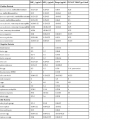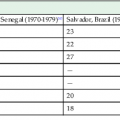Roberta L. DeBiasi, Kenneth L. Tyler
Orthoreoviruses and Orbiviruses
The Reoviridae family of viruses consists of nine genera, whose members have a widely varied host range, including plants and invertebrate (insects, crustaceans) and vertebrate (mammalian, reptilian, avian) animals. Five genera have been etiologically linked with diseases of humans: Orthoreovirus, Orbivirus, Rotavirus, Coltivirus, and Seadornavirus. The genome of all Reoviridae consists of linear double-stranded RNA surrounded by a nonenveloped icosahedral capsid 60 to 80 nm in diameter. Genomic material is organized into 10 to 12 segments, which are capable of reassortment and resultant generation of novel viruses.1 In this chapter clinically relevant information is presented pertaining to human infection due to orthoreoviruses and orbiviruses. Rotaviruses, coltiviruses, and seadornaviruses are discussed in Chapters 151 and 152.
Orthoreoviruses
Background and Epidemiology
Reoviruses were first discovered in the 1950s after isolation from human enteric specimens, and they were subsequently documented to infect a wide range of hosts. Reovirus serotypes 1, 2, and 3 are found ubiquitously in the environment, and their sources include stagnant and river water and untreated sewage. The term reovirus is an acronym for respiratory enteric orphan virus, which emphasizes the anatomic site from which these viruses were initially isolated as well as the fact that infection of humans, although common, is only rarely associated with significant disease. Human infection primarily results in either asymptomatic infection or mild, self-limited symptoms such as upper respiratory tract illness and gastroenteritis.2,3 Rarely, reoviruses have been identified as the causative agent in human cases of meningitis, encephalitis, pneumonia, and myocarditis and are potentially associated with biliary atresia and choledochal cysts (discussed later).2–4 Serologic studies of reovirus prevalence have documented steady increases from infancy (5% to 10% seropositivity at 1 year of age; 30% at 2 years of age; 50% at 5 years of age) through adulthood (50% at 20 to 30 years of age; >80% by 60 years of age),4,5 reflecting immunity acquired as a consequence of natural infection. Despite this, it has been difficult to provide convincing evidence linking reoviruses to specific human diseases. Transmission occurs by the fecal-oral and airborne routes in humans. Reovirus infection serves as an important experimental animal model of viral encephalitis and myocarditis, a presentation of which is beyond the scope of this discussion but is reviewed in Chapters 86 and 91.6
Clinical Disease
Respiratory Tract Manifestations
Mild upper respiratory tract illness consisting primarily of rhinorrhea and pharyngitis accompanied by low-grade fever, headache, and malaise (35% to 80%), with or without mild diarrhea (15% to 65%), has been described in children during outbreaks and was produced in experimental reovirus infections of adult volunteers.7,8 In children, a maculopapular (and, in one case, vesicular) exanthem has been described,4 as has otitis media. Rarer reports of lower respiratory tract disease have included interstitial or confluent pneumonia, one of which was fatal.9,10 A novel reassortant reovirus designated as BYD1 strain was isolated in 2003 from five patients with severe acute respiratory syndrome (SARS) who were coinfected with SARS-associated coronavirus. Subsequent characterization in animal experimental models has suggested a possible copathogenic role for this virus in SARS.11,12 More recently, two new and closely related reoviruses (Melaka and Kampar viruses) have been identified and characterized from six adult and pediatric Malaysian patients with acute respiratory tract infection.13,14 Both viruses are presumably of bat origin with transmission to humans by bat droppings or contaminated fruits. Index adult cases suffered from high fever, chills and rigors, sore throat, headache, and myalgia. Human-to-human transmission has been substantiated by serologic analysis of secondary cases, including children.
Gastrointestinal and Hepatobiliary Manifestations
A long-term study of children with diarrhea implicated reoviruses in only 0.1% of cases, and those occurred mainly in infants younger than 1 year.2 A role for reovirus infection in the pathogenesis of extrahepatic biliary atresia and choledochal cysts has long been proposed based on similarities between pathologic changes observed in pediatric patients suffering from these diseases and reovirus-infected mice.15 However, results from serology-based, as well as more recent molecular-based, studies are conflicting.15,16 In one study, reovirus RNA was detected in hepatic or biliary tissues from 55% of patients with extrahepatic biliary atresia and 78% of patients with choledochal cysts, compared with 21% of patients with other hepatobiliary diseases and 12% of autopsy cases.15 However, a subsequent study failed to detect reovirus genome in hepatobiliary tissues taken from 26 patients with extrahepatic biliary atresia and 28 patients with congenital dilation of the bile duct.16 No convincing data exist to support an etiologic role for reovirus infection in the setting of idiopathic cholestatic liver diseases in adults.
Central Nervous System Manifestations
Reovirus types 1, 2, and 3 have been isolated from cerebrospinal fluid of infants with meningitis, systemic illness, or both. Reovirus type 1 was isolated from a previously healthy 3-month old with symptoms of meningitis, diarrhea, vomiting, and fever.17 Reovirus type 2 (subsequently identified as a new mammalian reovirus type 2 Winnipeg) was isolated from the cerebrospinal fluid of an 8-week-old presenting with active varicella-zoster virus infection, Escherichia coli sepsis, intermittent fever, diarrhea, and feeding intolerance.18,19 A novel serotype 3 reovirus (T3C/96) was isolated from a 6-week-old child with meningitis and was subsequently shown to be capable of producing lethal encephalitis in neonatal mice.20 A novel reovirus strain (serotype 2), MRV2Tou05, was implicated in two cases of acute necrotizing encephalopathy in children from the same family.21 These reports illustrate the rare but possible neuroinvasive potential of reoviruses in the human host.
Stay updated, free articles. Join our Telegram channel

Full access? Get Clinical Tree








